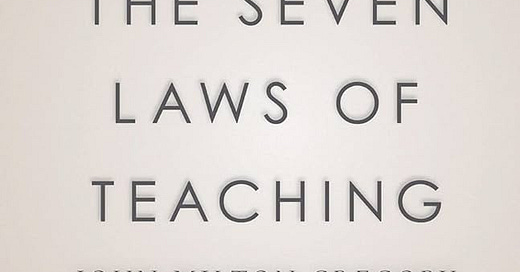As an Amazon Associate I earn from qualifying purchases
John Milton Gregory. The Seven Laws of Teaching: Unabridged. Foreword by Doug Wilson. Moscow, ID: Canon Press, 2014.
There are a handful of books that school administrators give to new teachers, regardless of whether they are only new to their school or if they are new to the teaching profession itself. John Milton Gregory’s The Seven Laws of Teaching is one of them. When I first read this little book, I’d already been teaching in the classroom for five years. Upon my first read, I found it to be the most elementary book I had encountered on the art of teaching. In fact, about halfway through I became frustrated with what, to my mind, was the repetition of the most basic essentials of being a Christian educator. It was at that point (somewhere in the middle of “The Law of the Language”) that two things occurred to me: first, that I had been the recipient of truly wonderful training when I first entered the ministry of Christian education, and second, that I was surely missing something. It wasn’t too much further into the book that I realized the truth of the latter.
The first pedagogical insight came in “The Law of Teaching.” Gregory highlights the importance of the active role for a learner, and phrases it beautifully: “teach him nothing he can learn himself” (82). How ought the teacher mold their students into being a “truth-finder” in the same vein that Gregory was meaning (83)? While I had always taken pride in the fact that I taught truth, and I encouraged students to think through things, I had not developed a habit of combining the two to shape young men and women who want to actively discover truth in this world. In the classical education world, this is often most discussed in relation to the Socratic method. The idea is that this Q & A approach pushes students to find truth in their own words and in the words of what is being studied in class. The second insight struck me while reading the final principle, “The Law of Review.” While it seemed another elementary idea at first, I soon realized that I was very poor at properly executing the essential act of review with my students. For exams or other major assignments, it was not a problem. But Gregory reminded me of the necessity to review with students more regularly and its role in forming the students for something more than mere success on an assignment (119, 130). Like many schools, the one where I taught for the past nine years asked teachers to revisit this little book at the end of each year. What started out as a “boring” read for me quickly became a vital guide to being a better teacher each year, which only reinforced in my own mind the very need for this final Law.
Veritas Press did the Classical Education world a favor by bringing Gregory’s book back into print in 2004, which is the edition I first read. Then, in 2014, Canon Press printed their own edition with some added features. The new book includes a new introduction, some templates for creating teacher reviews using the Seven Laws, and some discussion questions for group readings. These aspects make the purchase of the new edition worth the money (and even having a second copy lying around the house). The introduction is pretty typical Doug Wilson. If you like Wilson, then you’ll love it; if you don’t like Wilson, then you’ll hate it. Either way though, he does a good job of capturing why teacher training is such an essential part of a Classical Christian school’s job, a concept few schools would reject. It is the templates in the Appendices that are most worth the purchase, though. Dr. Larry Stephenson created these materials, and they work remarkably well. Over the years I’ve seen many schools develop their own teacher evaluation tools using the Seven Laws, and I’ve watched as schools flounder to adapt them to their own context. What works in one school won’t necessarily work in another. But Stephenson’s templates seem to understand this and are thus constructed in a way that makes them highly adaptable. For newly founded schools, I think this edition of the book would be invaluable, especially as administrators and teachers think through how to make full use of Gregory’s little book.
Sean C. Hadley is a graduate of New Orleans Baptist Theological Seminary (MDiv, 2017) and Faulkner University's Great Books program (PhD, 2023). His writings have been published in outlets such as The Imaginative Conservative, Touchstone magazine, and The Hemingway Review. He has given conference talks in a variety of settings, such as the annual Repairing the Ruins education conference and the annual Spring conference of the Ciceronian Society. For the last fifteen years, he taught in the classical Christian classroom, and he is currently the inaugural Postdoctoral Research Fellow with the Classical Education Research Lab at the University of Arkansas.




